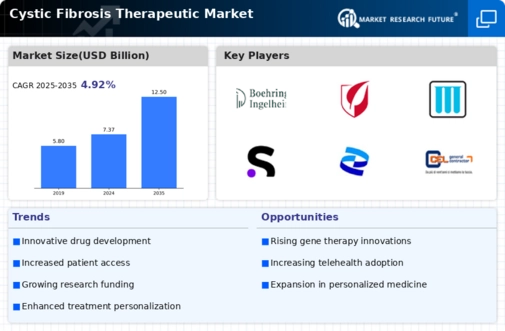Growing Awareness and Advocacy
Growing awareness and advocacy for cystic fibrosis are pivotal in shaping the Cystic Fibrosis Therapeutic Market. Increased efforts by patient advocacy groups and healthcare organizations have led to heightened public understanding of the disease and its impact on patients' lives. This awareness is crucial in driving demand for effective therapies and influencing policy decisions regarding funding and research initiatives. As more individuals become informed about cystic fibrosis, there is a corresponding increase in support for research and development efforts. This trend is likely to encourage pharmaceutical companies to prioritize cystic fibrosis in their portfolios, ultimately leading to a more competitive market landscape. The synergy between advocacy and market dynamics is expected to foster growth within the Cystic Fibrosis Therapeutic Market.
Innovations in Drug Development
Innovations in drug development are significantly influencing the Cystic Fibrosis Therapeutic Market. The emergence of novel therapies, particularly those targeting the underlying genetic mutations responsible for cystic fibrosis, has transformed treatment paradigms. For instance, the introduction of CFTR modulators has shown promising results in improving lung function and overall quality of life for patients. The market is projected to witness substantial growth, with estimates suggesting a compound annual growth rate of over 10% in the coming years. This surge is attributed to ongoing clinical trials and the potential approval of new therapies that could address unmet medical needs. As pharmaceutical companies continue to explore innovative approaches, the Cystic Fibrosis Therapeutic Market is poised for dynamic evolution.
Regulatory Support for New Therapies
Regulatory support for new therapies is an essential driver in the Cystic Fibrosis Therapeutic Market. Regulatory agencies are increasingly recognizing the need for expedited approval processes for innovative treatments that address serious health conditions like cystic fibrosis. Initiatives such as the Orphan Drug Act have incentivized the development of therapies for rare diseases, facilitating faster access to life-saving medications. This supportive regulatory environment encourages pharmaceutical companies to invest in research and development, knowing that there is a pathway for bringing their products to market efficiently. As a result, the Cystic Fibrosis Therapeutic Market is likely to experience a surge in new therapies, enhancing treatment options for patients and improving overall health outcomes.
Rising Prevalence of Cystic Fibrosis
The increasing prevalence of cystic fibrosis is a notable driver in the Cystic Fibrosis Therapeutic Market. Recent estimates indicate that approximately 30,000 individuals are living with cystic fibrosis in the United States alone. This growing patient population necessitates the development of effective therapeutic options, thereby stimulating market growth. As awareness of the disease expands, more individuals are diagnosed, leading to a higher demand for innovative treatments. The rise in prevalence is also linked to advancements in diagnostic techniques, which allow for earlier detection and intervention. Consequently, pharmaceutical companies are likely to invest more in research and development to address the needs of this expanding demographic, further propelling the Cystic Fibrosis Therapeutic Market.
Increased Investment in Research and Development
Increased investment in research and development is a critical driver for the Cystic Fibrosis Therapeutic Market. Pharmaceutical companies are allocating substantial resources to discover and develop new therapies, reflecting a commitment to addressing the complexities of cystic fibrosis. In recent years, funding for cystic fibrosis research has seen a notable uptick, with public and private sectors collaborating to advance treatment options. This influx of capital is likely to accelerate the pace of innovation, leading to the introduction of more effective therapies. Furthermore, partnerships between academic institutions and biotech firms are fostering a collaborative environment that enhances the research landscape. As a result, the Cystic Fibrosis Therapeutic Market is expected to benefit from a robust pipeline of new treatments.

















Leave a Comment